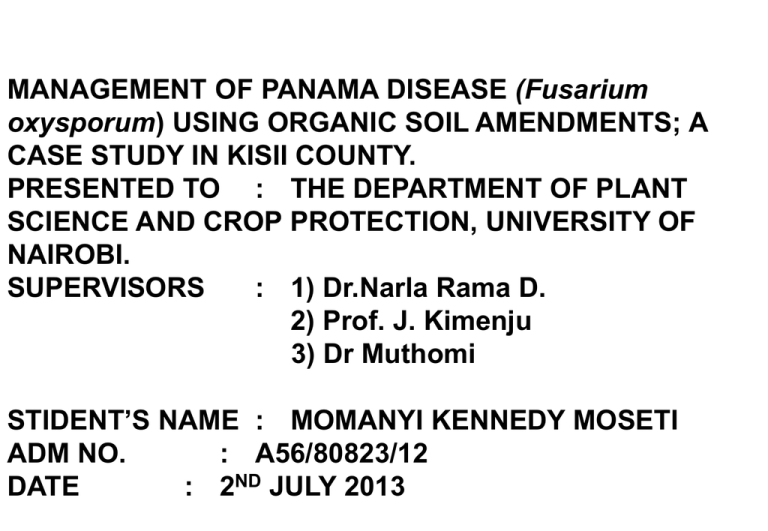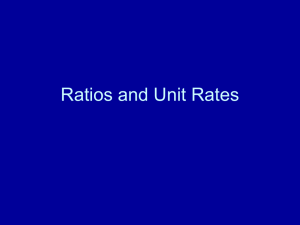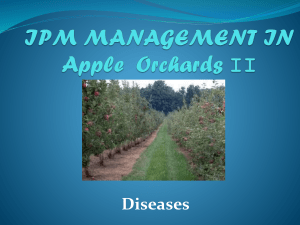MOSETI PRESENTATION - Department of Plant Science & Crop
advertisement

MANAGEMENT OF PANAMA DISEASE (Fusarium oxysporum) USING ORGANIC SOIL AMENDMENTS; A CASE STUDY IN KISII COUNTY. PRESENTED TO : THE DEPARTMENT OF PLANT SCIENCE AND CROP PROTECTION, UNIVERSITY OF NAIROBI. SUPERVISORS : 1) Dr.Narla Rama D. 2) Prof. J. Kimenju 3) Dr Muthomi STIDENT’S NAME : MOMANYI KENNEDY MOSETI ADM NO. : A56/80823/12 DATE : 2ND JULY 2013 INTRODUCTION Panama disease is widely known as one of the most destructive banana disease all over the world where bananas (Musa spp) are grown. The first incident of the disease was reported in 1876 in Australia (Randy C.Ploetz Dec. 2000). It is a soil borne fungus that induces panama disease in host plant by preventing sap movement in the xylem vessel (Beckman Aps 1990). The fungus also exists in plant debris. It gains entry into the banana plant often through bruises on the roots. Therefore the disease starts by attacking the roots of banana plants. Though the disease has been in existence since 19th century, it took until 20th century to wipe out plantations of the crop in Panama and other parts of the world. The most popular banana variety in Panama: ‘Gross michel’ comprised all the export production then. Its susceptibility to Fusarium wilt, threatened complete wipe out of banana production. Other resistant strains are in use nowadays but the Fusarium fungus keeps evolving therefore making the banana growing regions insecure in the future prospects of the crop industry. Also banana plants are at a disadvantage because they have inability to produce viable pollen hence unable to achieve reproduction by sexual means. Therefore, the crop’s asexual reproduction perpetuates in subsequent generations of the crop that are genetically identical and hence susceptible to the same disease. This disease is present in major banana growing areas of Kenya e.g. Kisii, Homabay, Meru, Murang’a, Kakamega, Busia, Kisumu, Migori, Taita Taveta and Coast region. Affected varieties in Kenya are the dessert bananas such as Bogobogo, Bogoya, Kisukari and Muraru where up to 80% of the banana field may show symptoms of the disease. In Africa Fusarium types 1, 2, 3 and 4 exist affecting bananas but in Kenya only types 1 and 2 have been confirmed to exist. Fusarium wilt severity is increased by stress situations that generate lack of vigor in the plant such as: Long flooding periods Unbalanced nutrition Low temperatures High salinity e.t.c. (Stover BPAD 1972, Galan LFTS 1992). In addition, banana plants produced by tissue culture suffer increased susceptibility to the disease when they are planted in the field (Promusa P 1999). PROBLEM STATEMENT Kisii County is known countrywide for its potential in banana production for both subsistent and commercial purposes.Most types of banana varieties are grown for cooking as well as for fruit production as ‘dessert fruits’. The cooking varieties have been established to be resistant to Fusarium oxyporum (Dr. Margaret Onyango: Panama disease enemy to dessert banana production July 2005) whereas the dessert varieties are susceptible. The dessert varieties on the other hand fetch more income to the farmers as opposed to the cooking varieties. Their shelf life is long; retaining the taste, colour and texture. It has also been established that the panama disease is prevalent in warmer parts of the county like Kisii south district, Marani district as opposed to cooler districts like Nyaribari Chache, Nyaribari Masaba, Sameta district, Kenyenya district, Gucha district e.t.c. Banana is the second income earner to the farmers in the Kisii County after Tea and it is also second as a staple food after maize. Therefore the presence of the disease affects the economy of the county seriously. The county is also conducive for animal production particularly livestock, poultry, rabbits e.t.c. whose manure is available in reasonable quantity but are not properly utilized for economic purposes. The availability of the manure provides the potential that will underline this study in trying to manage the panama disease. Also the warmer parts of the county provide suitable sites for setting up the experiment. BACKGROUND INFORMATION; Banana and planting (Musa sp) is the fourth most important global food commodity after rice wheat and maize in terms of gross value production (Onyango Margaret 2009). It is an important staple food for millions of people in developing countries of the tropics where they play a pivotal role in food security. In East African region, much of banana production is done by small scale farmers where over 90% of the produce is consumed localy. The most common banana cultivars grown widely in Kenya include; Source; Onyango M, Nguthi F, Mutisya J, Muniu F 1998 Genome group Cultivar name Province common grown in End product AAA-EA N’gombe Nyanza, Western, Cooking Ekeganda Central Sialamule Ishighame AAA Dwarf Cavendish Taveta Coast Dessert Giant Cavendish Central Dessert Valery Central Dessert Dessert Israel Kampala(Gross Michel) AA Muraru Central ABB Bogobogo Bomet,Nyanza AAB Kisukari Central, Western Kisii ndizi Nyanza Dessert Banana industry is intimately linked to the disease that have afflicted and continue to afflict this major commodity in world trade (Jeger et al 1995, Onyango M 2009). The industry has seen a surge in pest and disease in recent years that have lowered yields and plantation lifespan. Due to this a popular variety such as Gross Michel has been replaced by Cavendish as a result of loss in the resistance to race one of panama disease. In one of their participatory rural appraisal exercises’ (PRAs) carried out in Kenya, diseases and pests were found to be the major limiting factors in banana production in most banana growing areas. Among these pests and diseases, the following majored: Banana xanthomonas wilt (BXW), Sigatoka, Panama, Banana Weevil, and Parasitic nematodes. If the banana crop is to be protected then there must be a strategic plan for control of pests and diseases (Onyango M 2009) Banana production constraints in Kenya: PRAs conducted in 1996-1997 in Nyanza, Central, Eastern, and Coast. Preliminary surveys BXW 2007. In one of my field surveys with Kari Kisii staff and extension staff from the ministry of agriculture in the farms of ten farmers in both Suneka and Mosocho areas on fifth July 2013, the following was noticed on a” world bank” sponsored project; 1.FHIA-17 Hybrid AAAA did very well and was resistant to both Panama and Sigatoka diseases 2.GT was tolerant 3.Cavendish was tolerant 4.Apple banana/”Kisukari ndizi” was susceptible and indeed in some farms they were completely wiped out, others they were stunted as opposed to other varieties planted at the same time. Province Constraints Cultivars affected most Coast Black Sigatoka Cavendish Central and Eastern Panama disease Kampala Nyanza/Western BXW All cultivars, Panama disease Kisukari or Kisii ndizi Sigatoka All cultivars Moles Weevils and Nematodes PRAs conducted in 1996-1997 in Nyanza, Central, Eastern, and Coast. Preliminary surveys BXW 2007. In one of my field surveys with Kari Kisii staff and extension staff from the ministry of agriculture in the farms of ten farmers in both Suneka and Mosocho areas on fifth July 2013, the following was noticed on a” world bank” sponsored project; 1.FHIA-17 Hybrid AAAA did very well and was resistant to both Panama and Sigatoka diseases 2.GT was tolerant 3.Cavendish was tolerant 4.Apple banana/”Kisukari ndizi” was susceptible and indeed in some farms they were completely wiped out, others they were stunted as opposed to other varieties planted at the same time. BROAD OBJECTIVE This research is set to determine the effect of organic soil amendments (poultry manure ,ash, Tithonia and press mud) application on panama disease in infected bananas, the appropriate soil amendment that can manage the disease and determine if the PH has a direct effect on the disease development Specific objectives 1.To determine the suitable organic soil amendment that can help manage panama disease and boost yield in “ Kisukari ndizi”. 2.To determine the PH range within which panama disease development is encouraged. HYPOTHESES •Sustained use of organic soil amendments helps to manage panama disease and boost yields in “Kisukari ndizi” •Panama disease development is encouraged within a particular PH range. JUSTIFICATION Fusarium wilt (panama disease) is a serious problem in Nyanza, Western, Central, Eastern and Coast provinces in Kenya. It affects particularly ‘apple’ bananas or ‘Sukari ndizi’ but other bananas such as Gros michel (Bogoya), Bokoboko and silk are also affected to a lesser extent (Onyango M.; Kari information brochures series 67/2008). Farmers in Kisii County practice mixed farming where animal manure is readily available which can be utilized in the management of this disease. In addition, there are prominent farmers in the region who have specialized in poultry production from where poultry manure is available and sold at 400/= per bag (5 debes). Other farm manures are available like press mud from Sony sugar factory, Trans-Mara sugar factory. Farmers are allowed to take any quantity they need free without any restrictions. The problem may arise on transportation but serious farmers can join hands and hire a track/ lorry that can carry a lot of press mud at ago for their respective farm use. Finally it is noted that research is needed in other areas such as: 1.The influence of environmental and edaphic conditions on the development of this disease is incompletely understood (stores and Buddenhagen 1986). 2.The epidemiology of the TR4 outbreaks is confusing i.e. the Cavendish epidemics have developed in plantations that were established from tissue-culture plantlets (supposed pathogen free) and in areas without a recent history of banana cultivation (stores and buddenhagen 1986). Therefore, this proposed research is intended to address one aspect of edaphic environment (soil pH) and the effects of organic soil amendments on panama disease development and management. METHODOLOGY The experimental design will be a completely randomized block design on three sites; Suneka division, Mosocho division and Kari Kisii regional centre. In each division I proposed to randomly pick ten farmers on whose farms the study will be conducted. I also intend to involve the area Agricultural staff in randomly selecting the farmers. In each farm we will work on five stools. Therefore to realize the specific objectives I propose to do the following: 1.(a) Collect soil samples and infected crop parts; isolate and culture the disease causing pathogen. (to be analyzed at Kari Kisii laboratories and University of Nairobi Kabete college laboratories). (b) Chop the infected plants and then apply; two kilograms tin-full of ash, two kilograms tin-full of poultry manure, two kilograms tin-full of Tithonia, two kilograms tinfull of press mud each to respective chopped banana mats. This is repeated on monthly basis for a duration of six months. 2. To collect soil samples from the selected sites and determine the soil pH that predisposes the bananas to disease development. This will be done twice; before the onset of the experiment and after the experiment is completed. The soil samples will be analyzed at Kisii Kari laboratories and University of Nairobi, Kabete college laboratories to get the soil pH data. 1.Manage panama disease and boost “Kisukari ndizi” banana yield and hence generate increased income to banana farmers in Kisii County. 2.MSC. Research Thesis. BUDGET No 1 Item Manure 2 Hire of pick-up Unit cost @Ksh a) 20 farmers x 3 bags of manure = 180 bag x @400/= per bag a) Kari 3 stools x 400/= per bag Each will carry 10 bags x 18 trips x @5000 3 Preliminary planning meetings a) 4 Collecting soil samples 5 Infected banana samples 6 b) a) b) c) Refreshments @5000 x 2 sites (Suneka + Mosocho) Kari Kisii @2,000 Collecting bags @ 2,000 x 21 Transport/Fare @2,000 x 3 technicians pH laboratory determination @10,000 a) b) Total in Ksh 72,000 1200 90,000 10,000 2,000 42,000 6,000 10,000 42,000 10,500 21,000 Hiring field staff (five ) Collecting bags @2,000 x 21 Laboratory; isolation and culturing @ 500 x 21 samples c) Laboratory examination and identification @1,000 x 21 samples Five months @5,000x5 7 Fare and accommodation for senior staff a) b) 30,000 48,000 8 Miscellaneous Three lecturers @10,000 Project coordinator; twice a month @4,000 x 2 x 6 months 125,000 50,000 Time lines for the two year MSc agricultural resource management programme: 2012/2013 intake 2012 Activity Semester 1 Semester 2 Proposal Presentation Research work Data collection, entry and analysis Data entry and analysis Compilation of thesis Complete experiments Data interpretationThesis evaluation by supervisors Thesis submission to BPS S O 2013 N D J 2014 F M A M J J A S O N D J F M A M J J A S REFERENCE 1. Narla Rama D.2012 Msc Crop protection training manual. 2.Onyango Margaret 2005, Panama disease; enemy of dessert banana production. Kari Kisii. 3.Onyango Margaret 2009, Banana diseases and their management. Kari Kisii 4.M.Ferna’ndez- Falcon, C.E. Alvarez, R. Gorrin, M.M Herna’ndez and A.A Borges 2009;Influence of a Menadion derivative on banana panama disease developments and yield enhancement. 2 :49-53 5.Ploetz, R.C 2005. Panama disease; An old Nemesis rears its ugly Head Part 2. The Cavendish era and beyond. On line APSnet Features, doi:10.1094/APSnet Feature2005-1005. 6.Ploetz,R.C 2006a. Fusarium wilt of banana is caused by several pathogens referred to as Fusarium oxysporum f.sp.cubense.Phytopathology 96:653-656.






